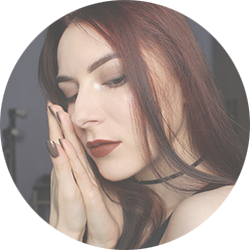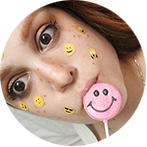







Welcome Back
Sign in to be closer to your community!
Follow other divas, like and comment
on their posts, message them, and see
who loved your posts!
Invalid username or password
You have not verified your account by clicking on the link we sent you via email. Please check your email folders (including your Spam folder) and click on the verify link sent.
Email is required
Password is required








Join FashionPotluck.com
Create your own profile in order to create content, follow other divas and like their posts, use our own messenger, and be a part of a growing international women community!
WELCOME TO OUR COMMUNITY
Fashion Potluck -
the first social media
platform for women.
You are free to read/watch & create content,
express your true self, and interact with others.
Join for free
Already a member? Log in here.
Purchase Alert
Dear Queen, you can only buy from one seller at the time. Please finish this purchase first in order to buy from another FP member
Comments
Please select one platform to continue
Please select one platform to continue
Please select one platform to continue
Please select one platform to continue
Please select one platform to continue
Please select one platform to continue
Please select one platform to continue
Please select one platform to continue
EDITOR APPROVED
You are wondering what is this 'Editor Approved'?
Well, this is pretty awesome! In order for the post to qualify and receive this accolade, it has to have a minimum of 700 words and two images (at least one original).
Receiving this accolade means two things: 1) Your content is amazing! Good job! 2) Your content qualifies for our monetization program. Every week two of the most read posts receive monetary rewards.
Have the badge & want to monetize your content?

LIFESTYLE


From dream unicorns to imaginary friends… You hallucinate every day. Fact. But there’s a method in the madness. Here’s why your eyes lie to you.
Your brain is capable of incredible things, and conjuring up extremely convincing yet entirely fictional imagery is one of those things.
Hallucination is something that most people associate with drug use or psychotic disorders. But the truth is that we all experience hallucinatory imagery of different kinds on a daily basis.

Let’s start out with something not so shocking… One of the most obvious types of everyday hallucination is dream imagery.
Take a moment to remember one of your dreams. You know now that the dream environment was not your actual reality. It was a construct of sights, sounds, feelings and other sensations, chosen from a stockpile of memories in your mind.
But did that dream not seem entirely real at the time?
So, what’s the difference between these hallucinated dreamscapes and reality? This is the questions that has consumed the minds of philosophers and scientists for thousands of years. The answer seems to be: very little.
As far as the brain is concerned, the unicorn you talked to last night was no less real than the boss you had a meeting with this morning. It’s only what you decided afterwards that set them apart.
What the brain adds
In his fascinating book on perception, The User Illusion, Tor Nørretranders asserts that 90% of what we see, hear, feel, taste and smell is internally generated. This means that the vast majority of what we think we perceive around us is actually fabricated. It’s added by the brain a split second before conscious recognition.

You may have heard of the “blind spot” in human vision. This is a great example of the brain’s ability to create convincing imagery in lieu of actual information.
We all have two blind spots: one in each eye. There is a sheet of photoreceptors covering the retina at the back of your eye. This functions much like the photosensitive film at the back of an old-school camera. It records the information transmitted via rays of light from the outside world.
However, at the point where the optic nerve attaches to the retina, there’s a hole in this sheet. What this means is that the brain receives zero information from the eye about this particular part of the picture.
But we don’t have gaps in our vision. This is for two reasons: firstly, the blind spots in each eye are in different places so one eye sees what the other does not. However, if you close one eye, you still don’t have a big black hole in your sight because your brain is making up and filling in the missing part based on what surrounds it.
That part of your sight is literally an estimation of reality. An invention. And it’s not small either. Imagine the size of the moon in the night’s sky. Your blind spot could delete a moon eight times the size of that.
To actually see the blind spot being filled in, you can use the image below.
Instructions: Cover your left eye with your hand and focus on the cross with your right eye. Now, slowly move your head closer and further away from the screen. There will be a point — probably around six inches from the image depending on the resolution of your screen — at which the invisible man disappears. Don’t look directly at him, just keep looking at the cross and he’ll pop in and out of your peripheral vision.

More than just pictures
But what if the brain adds more than simple imagery to our everyday experience? Let’s take a look at another familiar illusion to explore this question:

This is called the Necker Cube. With this image, we’re presented with two different options. You either see a cube with a front panel in the bottom left as the foreground. Or, you see one with the front panel in the top right. You can alternate between the two different cubes, but you can’t see both at the same time.
The real point here, though, is that neither is true. Of course, you’re not looking at a cube at all; it’s just an arrangement of lines. However, although you know this to be the case, you cannot look at the Necker Cube without being aware of one of those cubes and recognising it as such.
What this means is that the brain has added a load of extra information to those lines in an instant, and presented us with something which is much greater than the parts from which it is made.
We look at straight lines and we see a whole object with added meaning; we register a percept.
The influence of personal experience
In 1781, Kant argued that there are in fact two worlds: the “nouminal world” which is the real, objective world; and the “phenomenal world” which is our version of the nouminal world as perceived inside our minds.
“The only way we can perceive the nouminal world is by its effects on the phenomenal world. Therefore the world we experience as external to our bodies is not actually the world itself, but only an internal virtual reality replica of that world generated by perceptual processes within our head.”
[Steven Lehar — The World In Your Head: A Gestalt View of the Mechanism of Conscious Experience ]
What informs the phenomenal world?
So, what we are seeing at any one time is nothing but our own, idiosyncratic version of reality. It’s much like the percept that we see when we observe the Necker Cube diagram. It’s embellished.
And just as the cube is perceived as a result of our prior experience with cubes, our phenomenal world is also affected by what we have experienced in the past. It’s based entirely on what we already know (or think) to be true.

Take this next illusion. As Nørretranders points out, this illusion “shows that we are living on a planet that orbits a star!”. The shapes in this image clearly appear as dimples or pimples depending on whether the “shadow” is at the top of the bottom of the circle. Of course, there is no shadow at all. These are just circles filled with a gradient. But having lived its life on a planet which receives light from the sun (i.e. from above), the brain interprets the gradient as a shadow. Consequently, it converts the circles into 3D protrusions and indentations respectively.
The role of identity and self-image
And finally, this lens through which we see things is comprised of more than just our beliefs about the external world. Our phenomenal world is also defined by our personal values systems, our self-beliefs and our sense of identity.
We tend to experience what we expect to experience. So whether we anticipate looks of admiration from our peers, or sneers of utter disdain, that’s what we’re likely to see. And it’s our self-beliefs which will inform those expectations.
Hallucination as an acquired skill
So hallucination isn’t something that just happens to us. It’s a skill. It’s learned by the brain as we grow up to help us make (rapid) sense of reality and ease our existence in the world.
Children’s imaginary friends are a classic example of this. In response to some kind of lack in the child’s life — company, love, protection, excitement, etc — the child’s mind creates another being for him to play with.
In the case of serious trauma or abuse, defensive hallucinations like this can endure into adult life. This would signal an ongoing need that the brain is forced to meet by some means of reality-warping. It’s only at this stage really that it could become a “problem”.
Adult imaginary friends are a somewhat extreme example though. As Stephen Wolinsky puts it in Trances People Live: “hallucinations occur along a continuum in which, typically, the more vivid the hallucination, the more vivid and entrenched the underlying trauma”.
At the harmless end of this spectrum you’ll find things like daydreams of becoming a movie star, playing football for England, or dating someone you’ve liked for a while. These too are based on a perceived lack: “Life would be better if I was rich and famous” or, “I wish I was more loveable”. But fantasies of this kind can usually be stopped and started at will. The defining variable here is choice.
At the problematic end of the continuum, the individual has no choice over when they begin making up the contents of their phenomenal world based on a need to defend against past trauma or present pain. Hallucinations are the mechanics of our self-fulfilling prophesies. They’re how the mind makes true our existing beliefs (for better or worse).
What can we do about it?
So how can we change our hallucinations? Is it possible to stop imagining things which confirm our deepest fears, and instead see a world we’d be much happier to live in? Of course it is. I’m not saying that it’s easy, but there are various ways you could go about readdressing reality. he first step in all of this is to become aware of what, exactly, it is that you’re hallucinating. Obviously, this is not all that straightforward.
Really have a think about it. What do you see/hear/feel that other people say they don’t?
Or, what do you see/hear/feel which is painful and would potentially be a positive thing to change?
And once you know that, ask yourself: what do I believe about myself or the world that by seeing/hearing/feeling this thing, I’m actually making into a reality?
In doing this, you’re identifying your own limiting beliefs. Granted, this is a big consideration, and you may well encounter some resistance. It’s likely that you’ll find yourself rationalising those negative beliefs by coming up with evidence of their veracity. It’s this “evidence” which could potentially expose your go-to hallucinations.
And then it’s just a case of challenging them. Repeatedly.
Your mind is a learning machine. Given enough prompts, it’ll start to reassess its opinions. You’re ever evolving. So just because you have believed something in the past doesn’t mean you have to believe it in the future.
I’ll leave you with this quote:
“If you’re just making it all up, then why not make it up better?”
- Trevor Silvester, Founder of Cognitive Hypnotherapy
Hazel Gale is an athlete-turned-therapist and author of The Mind Monster Solution. Visit her profile for articles on cognitive psychology and self-help.
Comments
Related Posts
- What Makes Men’s Accessories Worth Investing In Today? by Ekim Fashion 0
- How to Plan Seasonal Plush Inventory Without Overbuying by Harnel Inc 0
- 6 Winter Season Reasons to See a Dermatologist ASAP by Monica Quinn 0
More Posts
- Affordable Embroidery Services | Free Design Assistance by Embroidery Designs 0
- Beyond the Hardwood: Finding the Fun in Absurd Physics Games like Basket Random by Suzanna Brown 0
- Why Cowboy Ties Are Making a Bold Fashion Comeback This Year by Rocky Mountain Western 0
Vote content out
Reason for voting this content out?
Reason for voting this content out?


 Login with Google
Login with Google Login with Twitter
Login with Twitter






 by
by
Add Comments